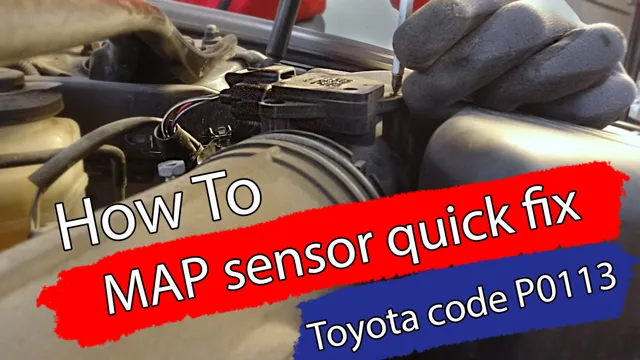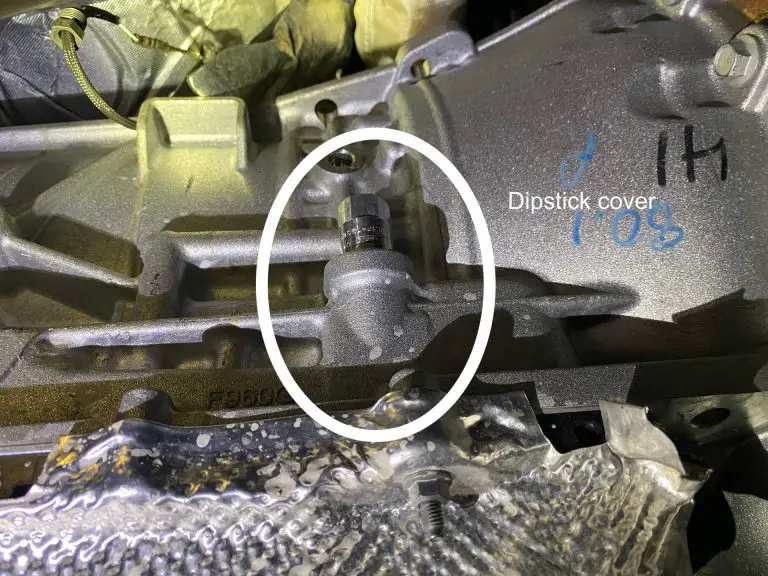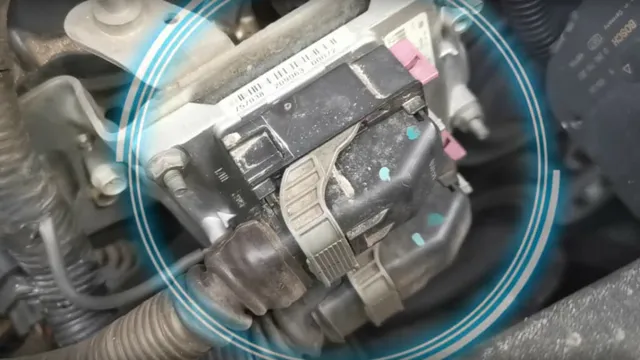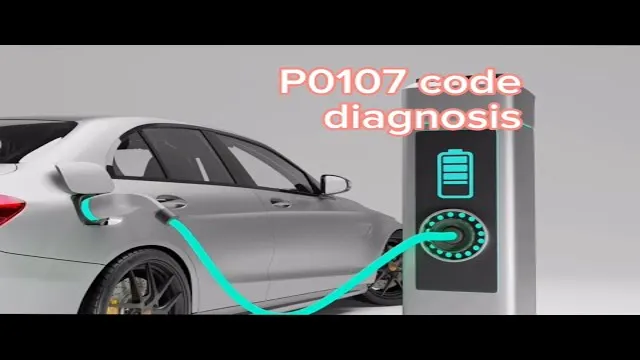Troubleshooting Made Easy: The Ultimate Guide to Fixing Code P0113
Are you stuck with Code P0113 on your car’s diagnostic trouble code (DTC) reader? It’s a frustrating and daunting task to fix, especially if you’re not an experienced mechanic. But worry not, as we’ve got you covered! In this comprehensive guide, we’ll walk you through everything you need to know about Code P0113 and how to fix it. Code P0113 is one of the most common trouble codes that you can encounter in a vehicle equipped with a modern engine management system.
This code refers to issues with the intake air temperature (IAT) sensor circuit. The IAT sensor is responsible for sending signals to the engine control module (ECM), which in turn adjusts the air/fuel mixture to optimize engine performance. If you’re experiencing Code P0113, then it’s possible that your IAT sensor isn’t reading the temperature correctly or is sending mixed signals to the ECM.
This can cause significant issues with your car’s fuel efficiency and overall performance. The good news is that fixing Code P0113 is not as complicated as it may seem, and with the right tools and knowledge, you can do it yourself. In this definitive guide, we’ll take you step-by-step through the entire process of diagnosing and fixing the issue.
We’ll cover all the basics, including how to check the IAT sensor’s wiring, how to test the sensor itself, and how to replace it if necessary. So, if you’re ready to get your car back up and running, read on and let us help you get that dreaded Code P0113 fixed in no time!
What is Code P0113?
If your check engine light is on and you’re experiencing a lack of power or poor acceleration, you may have a problem with code P011 This code refers to a malfunction in the Intake Air Temperature (IAT) sensor circuit. The IAT sensor is responsible for measuring the temperature of the air entering the engine, which is used by the engine control module to adjust fuel injector pulse width and ignition timing.
A faulty IAT sensor can result in incorrect sensor data being transmitted to the engine control module, leading to poor engine performance, increased emissions, and reduced fuel economy. To fix code P0113, you can perform an IAT sensor test with a multimeter or replace the sensor entirely. Make sure to check the wiring and connections for any signs of damage or corrosion, as this can also cause issues with the IAT sensor.
By addressing this code promptly, you can avoid further engine damage and potentially costly repairs.
Understanding the OBD-II System
The OBD-II system is found in most modern cars today and is responsible for diagnosing any issues with the vehicle. One of the codes that can be thrown by this system is Code P0113, which is related to the intake air temperature sensor. The intake air temperature sensor measures the temperature of the air going into the engine and sends this data to the car’s computer.
If the sensor is not working correctly, it can cause the code P0113 to appear. This can result in a decrease in engine performance, as the computer cannot properly adjust the air/fuel mixture to match the temperature of the air entering the engine. If you are experiencing this issue, it’s best to have a mechanic inspect the sensor and replace it if necessary.
Keyword: P0113, OBD-II system, intake air temperature sensor.
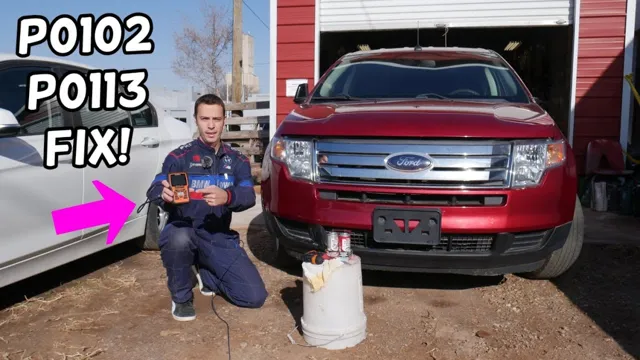
Symptoms of Code P0113
Code P0113 is a trouble code that appears when the Engine Control Module (ECM) detects an issue with the intake air temperature (IAT) sensor. The IAT sensor measures the temperature of the air entering the engine. When this sensor is faulty or there is an issue with the wiring or connection, the ECM may set a code P011
The symptoms of this code may include a decrease in engine performance, poor fuel economy, and erratic engine idle. Additionally, the check engine light may come on and the vehicle may fail an emissions test. It is important to address this code as soon as possible to prevent further damage to the engine.
If you suspect that your vehicle is experiencing any of these symptoms, it is recommended that you bring it to a certified mechanic for diagnosis and repair.
Troubleshooting Code P0113
If you’re experiencing code P0113 on your vehicle, don’t panic. This code indicates a problem with the intake air temperature (IAT) sensor circuit. The IAT sensor measures the temperature of the air entering your engine, which is then used to calculate the correct fuel and air mixture.
There are a few things you can do to troubleshoot and fix this issue. Firstly, check the wiring and connectors leading to the IAT sensor. Any damage or corrosion to the wiring can cause a false reading and trigger code P011
If everything looks okay with the wiring, test the IAT sensor with a multimeter to ensure it’s functioning correctly. If the sensor reads an incorrect temperature, it needs replacing. However, if both the wiring and sensor are fine, the problem could be with the engine control module (ECM).
In this case, it’s best to take your vehicle to a trusted mechanic for further diagnosis and repairs. Overall, fixing code P0113 can be straightforward with some troubleshooting and attention to the IAT sensor’s wiring and connections.
Diagnostic Steps
If you’re experiencing the error code P0113, it’s likely related to your vehicle’s intake air temperature (IAT) sensor. This sensor is responsible for measuring the temperature of the air entering your engine and providing that information to your vehicle’s computer. When the IAT sensor fails, it can cause a number of issues with your engine’s performance and fuel economy.
To diagnose the problem, there are a few steps you can take. The first is to check the wiring and connections to the IAT sensor to ensure they’re secure and free from damage. Next, you can test the sensor itself using a multimeter to measure its resistance.
If the readings are outside of the expected range, then the sensor is likely faulty and will need to be replaced. If replacing the sensor doesn’t fix the issue, then there could be a problem with the wiring or connections elsewhere in your vehicle’s system. A professional mechanic can help you diagnose the source of the problem and recommend the appropriate repairs.
Overall, it’s important to take code P0113 seriously and have it addressed promptly to avoid further damage to your engine and potentially costlier repairs down the line.
Testing the Intake Air Temperature Sensor (IAT)
The intake air temperature sensor (IAT) plays an important role in the engine management system of a vehicle. One of the common trouble codes associated with this sensor is P011 This code indicates that the IAT sensor is reporting excessively high input voltage, which can cause problems in the engine’s fuel-air mixture and ultimately lead to poor performance and increased emissions.
To troubleshoot this issue, the IAT sensor should be tested using a multimeter. The sensor’s resistance should increase with a decrease in temperature and decrease with an increase in temperature. If the sensor readings are out of range, it may be faulty and need to be replaced.
Regular maintenance and testing of the IAT sensor can help keep your vehicle’s engine running smoothly and efficiently.
Checking the Wiring and Connections
To troubleshoot code P0113, it’s essential to check the wiring and connections. This code indicates a problem with the intake air temperature (IAT) sensor, which is responsible for measuring the temperature of the air entering the engine. A faulty IAT sensor can cause a decrease in engine performance, fuel efficiency, and an increase in emissions.
One of the first steps in troubleshooting this code is to inspect the wiring and connections leading to the IAT sensor. Check if there are any loose or corroded connections, damaged wires, or broken connectors. These issues can cause a faulty signal or a loss of connection between the sensor and the ECU, resulting in the P0113 code.
By thoroughly checking the wiring and connections, you can resolve any potential issues, and restore your engine to optimal performance.
Fixing Code P0113
If your check engine light has come on and you’re receiving a P0113 error code, don’t panic – there are steps you can take to fix the issue. Code P0113 means that your vehicle’s intake air temperature (IAT) sensor is malfunctioning, which can lead to poor fuel economy and engine performance. To fix this issue, you can start by checking the IAT sensor’s wiring and connector for any damage or loose connections.
If these are intact, you may need to replace the sensor itself. Properly maintaining your vehicle’s sensors and wiring can help prevent issues like code P0113 from arising in the first place. By staying on top of regular maintenance, you can keep your vehicle’s engine running smoothly and efficiently.
Replacing the Intake Air Temperature Sensor (IAT)
If you’re experiencing code P0113 and suspect that it’s your Intake Air Temperature Sensor (IAT) causing the issue, then it may be time to replace it. The IAT sensor is responsible for measuring the temperature of the air entering your vehicle’s engine and relaying that information to the engine control module (ECM). If the ECM receives a signal that the air is too hot, it may reduce fuel efficiency or increase emissions.
On the other hand, if the signal suggests that the air is too cold, the engine may struggle to start. Replacing the IAT sensor usually involves locating the sensor, disconnecting the wiring plug, and removing the sensor with a socket or wrench. Then, you can install the new sensor, reconnect the wiring plug, and reset any error codes.
By taking care of this simple repair, you can ensure that your vehicle runs smoothly and efficiently, without any unwanted error codes.
Repairing the Wiring or Connections
If you’ve encountered error code P0113, the issue may be with the wiring or connections in your vehicle. This code pertains to the intake air temperature (IAT) sensor circuit, which can malfunction if there are any loose or damaged connections. To fix the problem, start by inspecting the wires leading to the IAT sensor and ensuring they’re securely connected.
If you notice any frayed or corroded wires, it’s best to replace them. In addition, check the wiring harness for any signs of damage or wear and tear. If everything looks okay, you may need to utilize a multimeter to test the IAT sensor’s resistance and voltage.
Remember, fixing the connections is a straightforward solution that could get your vehicle back on the road in no time.
Preventing Code P0113
If you’re dealing with trouble code P0113, there are a few things you can do to prevent it. This code indicates an issue with the intake air temperature (IAT) sensor circuit, which can cause problems with your vehicle’s performance. One way to avoid code P0113 is to make sure your IAT sensor is clean and free of debris.
Dirt and grime can build up on the sensor, causing it to malfunction. You can also check the wiring and connections to the IAT sensor to ensure they are secure and in good condition. If you’re still having trouble with code P0113, you may need to replace the IAT sensor altogether.
This will require a bit more work, but it’s a relatively simple fix that can be done with some basic tools. By taking these steps to prevent code P0113, you can keep your vehicle running smoothly and avoid any unnecessary headaches.
Maintenance Tips
If your vehicle’s Check Engine light has been activated and you’ve identified that the problem code is P0113, don’t panic. This code generally indicates an issue with the Intake Air Temperature (IAT) sensor, which measures the temperature of the air entering your engine. Fortunately, there are a few easy steps you can take to prevent this issue from happening in the first place.
First, make sure your air filter is clean and free of debris, as a clogged filter can cause incorrect readings from the IAT sensor. Additionally, avoid driving through areas with high dust levels and other contaminants that could clog your air filter. Regularly inspecting and potentially replacing your IAT sensor can also help prevent P0113 from appearing.
By following these maintenance tips, you can keep your vehicle running smoothly and prevent the frustration of dealing with a Check Engine light.
Driving Habits to Avoid
Preventing Code P0113 When it comes to driving habits, there are a few things you should avoid to prevent triggering Code P011 This code refers to a malfunction in the intake air temperature sensor (IAT), which can affect the engine’s performance and fuel efficiency. To prevent this, avoid aggressive driving habits such as sudden accelerations, hard braking, and high-speed cruising.
These behaviors not only put excessive stress on the engine but also cause significant temperature fluctuations that can damage the IAT sensor. Additionally, make sure your engine’s air filter is clean and free of debris. A dirty filter can also cause issues with the IAT sensor and trigger Code P011
By adopting responsible driving habits and maintaining your vehicle’s crucial components, you can prevent unnecessary trouble. Remember, safe driving isn’t just about protecting yourself and others on the road – it’s also about protecting your car.
Conclusion
In conclusion, fixing code P0113 is as easy as taking a dip in a cool pool on a hot summer day – well, almost. First, check your wiring and connections to ensure they’re all in good condition. Then, examine your intake air temperature sensor and see if it needs replacement.
Lastly, give your engine a thorough checkup to ensure everything is in tip-top shape. Just like finding relief from the summer heat, fixing P0113 requires a little effort, but once you’ve got everything squared away, your ride will run as smooth as a refreshing splash in the pool.”
FAQs
1. What does code P0113 mean? Answer: Code P0113 is a diagnostic trouble code that indicates a malfunction in the intake air temperature sensor circuit. 2. What are the symptoms of a P0113 code? Answer: The symptoms of a P0113 code can include poor fuel economy, rough idle, and hesitation during acceleration. 3. How do I diagnose a P0113 code? Answer: To diagnose a P0113 code, you will need a scan tool to check the sensor data for the intake air temperature sensor. You can also test the wiring and connections to the sensor. 4. What is the cost to fix a P0113 code? Answer: The cost to fix a P0113 code will depend on the root cause of the problem. It may be as simple as replacing the sensor or repairing a damaged wire or connector. In some cases, a more extensive repair may be required. 5. Can I drive my vehicle with a P0113 code? Answer: It is not recommended to drive your vehicle with a P0113 code, as it can lead to further damage to the engine and other components. It is best to have the issue addressed as soon as possible.

